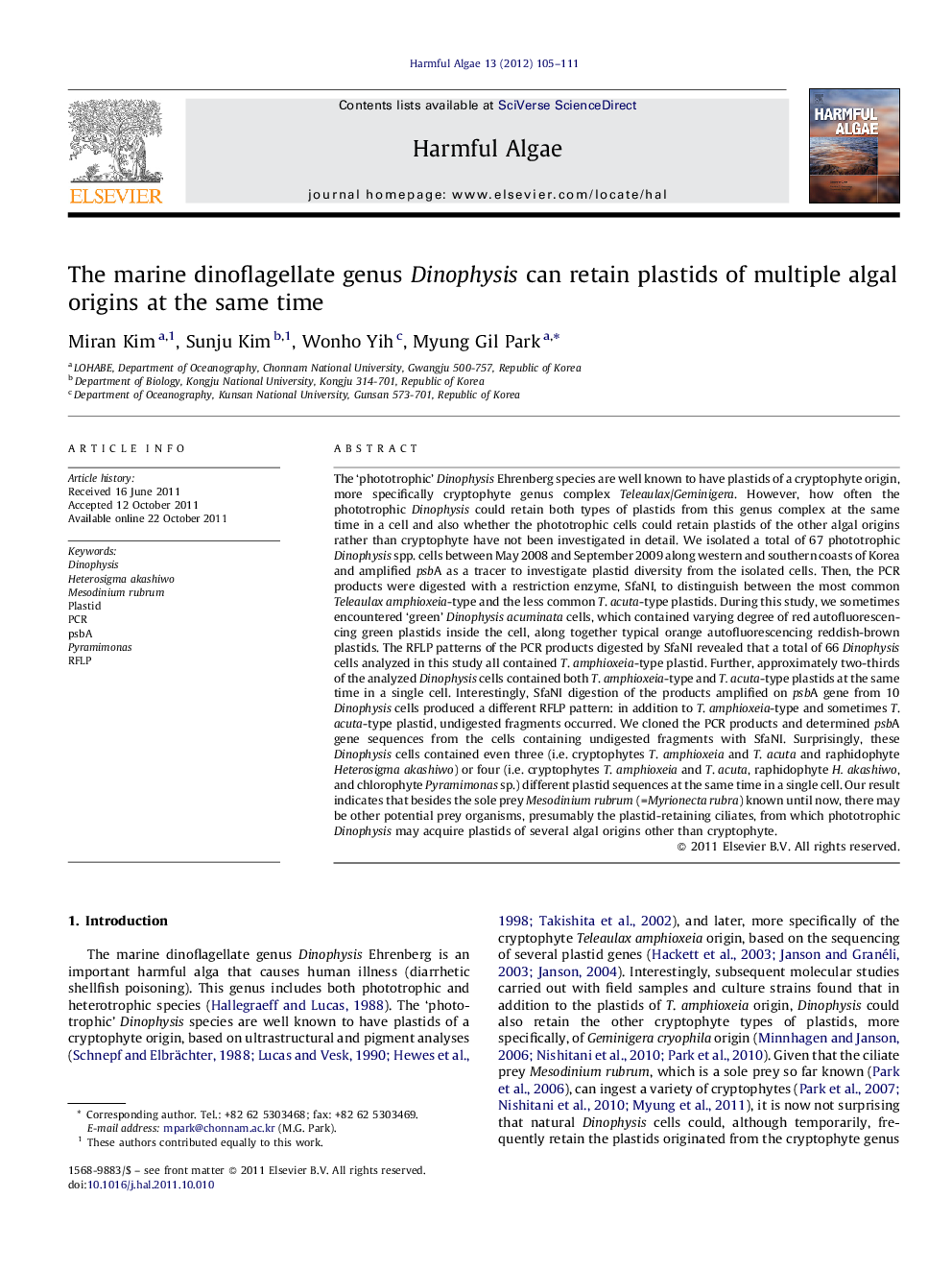| کد مقاله | کد نشریه | سال انتشار | مقاله انگلیسی | نسخه تمام متن |
|---|---|---|---|---|
| 4545662 | 1626957 | 2012 | 7 صفحه PDF | دانلود رایگان |

The ‘phototrophic’ Dinophysis Ehrenberg species are well known to have plastids of a cryptophyte origin, more specifically cryptophyte genus complex Teleaulax/Geminigera. However, how often the phototrophic Dinophysis could retain both types of plastids from this genus complex at the same time in a cell and also whether the phototrophic cells could retain plastids of the other algal origins rather than cryptophyte have not been investigated in detail. We isolated a total of 67 phototrophic Dinophysis spp. cells between May 2008 and September 2009 along western and southern coasts of Korea and amplified psbA as a tracer to investigate plastid diversity from the isolated cells. Then, the PCR products were digested with a restriction enzyme, SfaNI, to distinguish between the most common Teleaulax amphioxeia-type and the less common T. acuta-type plastids. During this study, we sometimes encountered ‘green’ Dinophysis acuminata cells, which contained varying degree of red autofluorescencing green plastids inside the cell, along together typical orange autofluorescencing reddish-brown plastids. The RFLP patterns of the PCR products digested by SfaNI revealed that a total of 66 Dinophysis cells analyzed in this study all contained T. amphioxeia-type plastid. Further, approximately two-thirds of the analyzed Dinophysis cells contained both T. amphioxeia-type and T. acuta-type plastids at the same time in a single cell. Interestingly, SfaNI digestion of the products amplified on psbA gene from 10 Dinophysis cells produced a different RFLP pattern: in addition to T. amphioxeia-type and sometimes T. acuta-type plastid, undigested fragments occurred. We cloned the PCR products and determined psbA gene sequences from the cells containing undigested fragments with SfaNI. Surprisingly, these Dinophysis cells contained even three (i.e. cryptophytes T. amphioxeia and T. acuta and raphidophyte Heterosigma akashiwo) or four (i.e. cryptophytes T. amphioxeia and T. acuta, raphidophyte H. akashiwo, and chlorophyte Pyramimonas sp.) different plastid sequences at the same time in a single cell. Our result indicates that besides the sole prey Mesodinium rubrum (=Myrionecta rubra) known until now, there may be other potential prey organisms, presumably the plastid-retaining ciliates, from which phototrophic Dinophysis may acquire plastids of several algal origins other than cryptophyte.
► We investigated plastid diversity of natural ‘phototrophic’ Dinophysis cells.
► D. acuminata cells sometimes contained varying degree of red autofluorescencing green plastids, in addition to typical reddish-brown plastids.
► Two-thirds of the analyzed Dinophysis cells contained both T. amphioxeia-type and T. acuta-type plastids at the same time in a single cell.
► Some Dinophysis cells contained even 3 or 4 different plastids.
► Our result indicates that besides the sole prey Mesodinium rubrum (=Myrionecta rubra) known until now, there may be other potential prey organisms.
Journal: Harmful Algae - Volume 13, January 2012, Pages 105–111